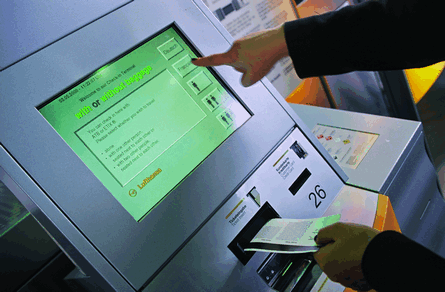The key to enhancing the self-service experience for passengers lies with existing and future mobile technologies
The rapid growth of self-service has been a major force for change and a great success for passenger services over the 10 years that the Airline Business/SITA Airline IT Trends Survey has been tracking this section of the industry.
Going forward, airlines are enhancing self-service solutions to ensure the total journey experience for passengers will be as stress-free as possible. This means providing greater functionality to kiosks and the online experience, but the great evolutionary leap forward for self-service looks set to come from mobile technologies - an area of keen interest for many of this year's survey respondents.
"The uptake of self-service technology is very good and holds great promise for the industry," says SITA chief executive Francesco Violante. "The evidence suggests that the more frequently people fly, the more likely they are to use self check-in. In fact, the usage of self-service technology, both from making a reservation or for checking-in for a flight, is already the primary channel for servicing passengers in some parts of the world or some specific airlines or airports."
The self-serviced journey starts with ticket sales and 91% of airlines now have their own websites, according to the 2008 survey, with 63% also using third-party online booking channels. Only 8% do not use web sales. On average 26.4% (weighted to passenger numbers) of ticket sales are made through the web - this is down on last year's average of 35.2%, but this can be partially explained by an influx of smaller airline respondents to this year's study. It could also be an issue of passenger demographics as Bill Miller, managing director of IT Services at Continental Airlines, explains: "We are raising a generation who are very savvy. They text each other, they use the internet, there's no barrier to it, they've been using e-mail all their lives. Whereas if you look at the people from the demography of today, there's a fair percentage who don't use e-mail and they're not about to learn how."
Miller is confident that web sales will grow as the tech savvy generation becomes economically empowered and web access increases - as television sets become more interactive and PC capable.
Web sales are higher than the industry average in some sectors - among the major carriers they average 28.2% (passenger weighted) and 74.6% (passenger weighted) among the low-cost carriers. In fact, the web is the main route to market for low-cost players, for which the challenge has moved beyond growing the web offer to enhancing it.
Where Is The Web Going?
"What we are interested in is where the web is going, particularly with the new generation of passengers born in the time of the web being around, who have a different view of technology and what the web can do for them," says easyJet IT director Tim Newling. "We are going to put a lot of work into improving our website progressively over the next few years. The overall standard of websites is hugely varied and I think having a great website increasingly will be a competitive advantage."
Others are keen to allow passengers to self-process as much as possible up to the point that they reach the gate. "The goal should be to move to the position where you greet your passenger after all possible unpleasant events (security, check-in and bag check) are passed," says Miller. "In my mind the ideal situation would be that the passenger and someone else was responsible for everything up to my greeting them in the lounge or on board."
The survey reveals that 59% of airlines now offer web check-in, with another 34% planning to do so in the next two years. Other self-services, both online and at the airport, are starting to take off, with a quarter of airlines providing online trip changing, and another 43% planning to do so by 2010. While 21% do offer self-boarding kiosks, this looks set to increase to 47% within two years. A small group now offers lost baggage self-service, and this looks set to grow to 44% over the same period. Within the next 12 months, over half of passengers will be processing themselves through check-in, with an industry average of 18% (passenger weighted) of people checking in via the internet, growing to 30% by 2009, and an average of 17% (passenger weighted) using kiosks, rising to 26% next year.
 |
|---|
© Lufthansa |
There is an expectation among airline IT bosses like Miller that internet and mobile check-in will eventually surpass kiosks, but that does not mean the end of kiosks. "During that time the kiosk will evolve into a service centre performing many functions now performed by agents and offering new services to the passenger," says Miller.
Replacing Kiosks
Over at British Airways, chief information officer Paul Coby regards kiosks as "transitional technology". BA's Innovation Unit is running a trial in Düsseldorf where kiosks are replaced with PCs and printers. "You can do a lot more with a PC than you can with a standard kiosk," says Coby. "Kiosks that are becoming more like PCs or are PCs could be a trend."
Adds Richard Clarke, director and co-founder of advisory firm Travel Technology Research: "Kiosks will continue to do what they do, but they will eventually offer opportunities to up-sell and maybe one day to cross-sell and service passengers through disruption handling."
 |
|---|
"The key challenge is that consumer technology - and the way consumers use that technology - is changing so quickly"Jamila Gordon |
The tipping point for increasing the functionality of kiosks could be the growth of common-use kiosks. Currently 67% (passenger weighted) of self-service kiosk deployments are dedicated user and this will decrease to 58% by the end of next year, while common user deployments now stand at 32% (passenger weighted) and look set to grow to 39% by the end of 2009.
"As we go to more and more common use it facilitates in many ways processes that you don't have when you had six or seven independent airlines," says Miller. "So over time we will see common-use for baggage check and other things."
The big self-service opportunities in the future will be around mobile telephones and mobile devices. Passenger notification services on mobiles are already offered by 42% of airlines and this looks set to double over the next two years. While 21% offer check-in via mobile now, another 46% are planning to do so by 2010.
There is also a buzz of excitement around new mobile services among survey respondents, with many considering other implementations. Supporting bar-coded boarding passes on mobile telephones is being considered by 72% of respondents, with 55% thinking about supporting payments via passenger mobile telephones, 40% about retail marketing of airline products on mobiles, 32% providing baggage receipts on mobiles and 22% thinking about using location sensing to improve passenger boarding.
"We are standing on the threshold of a new era in the air transport industry with the arrival of wireless broadband such as 3G and wiMax and new powerful mobile devices like Apple's iPhone and Google's Android platform. We will see a 'mobile web' integrating with customer applications that will be used for distributing products and servicing customers," says SITA's Violante. "There are opportunities to innovate at every point along the journey through mobile devices."
One test for self-services will be the ability to keep up with the fast pace of change. "The key challenge is that consumer technology - and the way consumers use that technology - is changing so quickly. However, this also represents an enormous opportunity," says Qantas chief information officer Jamila Gordon. "Airlines that succeed in allowing their customers to interact with them using any tool, any time, anywhere, will have a significant competitive advantage."
Bypassing Hurdles
IT Successes And Failures "One big success is that all our airlines use the same maintenance system - we set up a group to discuss common processes so we all use the system in the same way. We underestimated different source market needs in the in-flight retail area and the different needs from local civil aviation authorities because we tried to harmonise the processes and we underestimated the complexity" Gregor Deubert |
|---|
Despite the hurdles - among them diversity of mobile devices and operating platforms, availability of scanners in airports and security compliance - airlines are working towards solutions. WestJet, for example, is one of the first carriers in North America to get approval for Blackberry check-in, bypassing the complexities of bar-codes on mobiles by using e-mail.
"The lateral thinking is if you don't have to do it, why do it? And to me, we get a step on the market and that's the sort of thing that allows us to gain a little bit of edge on technology and do it in an efficient manner," says WestJet director of IT governance James Callaghan, adding that there has been good acceptance from business users.
But for Newling of easyJet, passenger services on mobile telephones are not by and large a technical issue. "It's a question of user adoption or how can you make money out of things," he says. "We're doing a trial sending people text messages on mobiles with flight confirmations. Very nice, but would people be prepared to pay for it and, if not, why would I do it?"
Air France already offers departure, arrival and gate information on mobile telephones and in June began trialling bar-code boarding passes on mobiles for flights between Paris Charles de Gaulle and Amsterdam Schiphol.
The challenge is having the IT infrastructure in place, according to Air France executive vice-president of information technology Edouard Odier, and the airline is now ensuring its systems will be ready for RFIDs embedded in mobiles, which will offer greater information capacity and reliability than bar-codes. "We are preparing ourselves to take advantage when it becomes mature in Europe," he says.
However, the stumbling block to smooth passenger self-service through the airport is baggage processing. "Quite often in most airports it's quicker to have a person deal with people than to have people take their bags elsewhere," says Newling.
Baggage processing and management is a high priority investment area for just 18% of airlines, with only 15% currently offering off-airport baggage check, rising to a third in the next two years. So why is off-airport baggage check-in of so little interest? "The answer is because they don't see a revenue opportunity yet," says Clarke at Travel Technology Research. "But maybe it becomes one in an unbundled world. It's customers' willingness to pay. It needs to be a business case that stands on its own."
As self-service continues to evolve, baggage processing will become a key area for future development, according to SITA's Violante: "Moving a queue or long wait time from one area to another is just moving the problem, so an end-to-end approach must be adopted, taking into account the whole passenger journey. Without this, good initiatives can quickly fail.
"There isn't a great deal of value to airports or passengers if kiosk check-in is fast and smooth but baggage drop-off points result in congestion," says Violante.
He adds: "It is fundamental that airports, airlines and ground handlers adjust their infrastructure and processes to offer effective baggage treatment in a self-service world, whether on- or off-airport."
To order the full results of the 2008 Airline IT Trends survey, available on CD, contact Laura Wood at: laura.wood@flightglobal.com
Source: Airline Business























